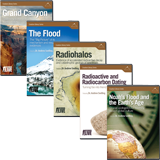
Supersized Landslides
Geology
Noah’s Flood ripped apart the earth. We’re not talking about boulders but whole mountains. In some places, slabs the size of cities slid dozens of miles in minutes.
According to God’s Word, the great Flood of Noah’s day was the most devastating catastrophe in history. If true, we would expect to find evidence of upheaval on a scale unlike anything we see today. And that’s what we find.
Geologists have discovered huge chunks of land that broke free during past super earthquakes and slid dozens of miles in just minutes. The next time someone questions Noah’s Flood, share the following example!
Two monster landslides happened near Yellowstone National Park. One is pretty famous in geology. Nearly every geology student learns about it; sometimes it’s called the Heart Mountain slide.
Yellowstone was once an active supervolcano. Suddenly a layer of sediments, nearly one-third of a mile (0.5 km) thick, broke free on the east side of the volcano and slid 30 miles (50 km) down a nearly flat slope. The landslide separated into smaller and smaller pieces as it traveled.
What makes this even more amazing is that it spread over 1,300 square miles (3,400 km2) in just a few minutes, attaining a top speed of nearly 100 mph (160 km/h). The Flood is the best way to explain this marvel.
The Heart Mountain slide seems to have set off a second slide, called the South Fork slide, located near Cody, Wyoming. This chunk was three-quarters of a mile (1.2 km) thick and moved another 3–6 miles (5–10 km). Because the Heart Mountain slide moved first, the South Fork slide re-transported, piggyback style, some of the Heart Mountain rocks.
The most amazing thing about the South Fork slide is that the sediments remained in layers and folded tightly at the leading edge. The only way to produce such folds is from a pile of fresh deposits during the Flood. Old, fully cemented sedimentary rocks do not fold; they break and crumble.
How could these slides move so fast across nearly flat ground? Again, the Flood is the best answer. Rapidly deposited sediments contain a lot of water. As the layers pile up, they squeeze the water out. The water becomes trapped between water-resistant layers like gypsum, similar to water trapped between two plexiglass sheets. Eventually the pressure became so great the layers slid after just a slight jiggle. Friction can also generate a layer of supercritical carbon dioxide—a condition where the gas gets so hot it acts like a fluid and lets the blocks “float.” This caused the Heart Mountain slide.
Secular scientists who deny the global Flood are baffled by the immensity of these slides and their speeds. Only conditions during the Flood can explain them.
Answers Magazine
April–June 2016
How well do you know the views of modern creationists? Test your knowledge and then discover how Christians can effectively share the gospel with homosexuals.
Browse Issue SubscribeRecommended Resources

Answers in Genesis is an apologetics ministry, dedicated to helping Christians defend their faith and proclaim the good news of Jesus Christ.
- Customer Service 800.778.3390
- © 2024 Answers in Genesis







